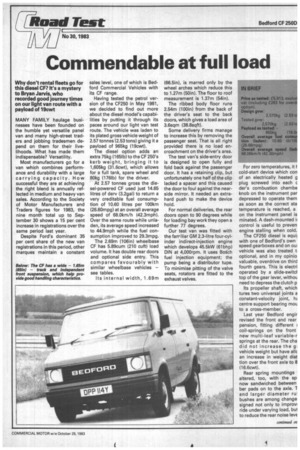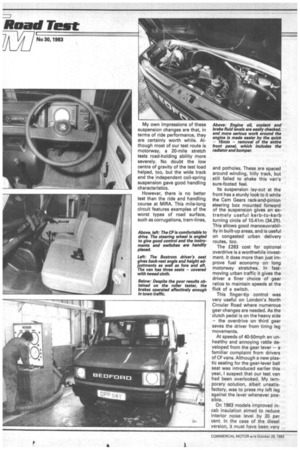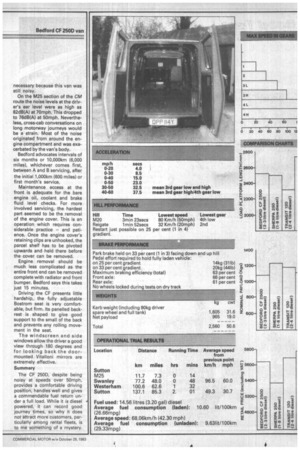Commendable at full load
Page 55

Page 56

Page 57

If you've noticed an error in this article please click here to report it so we can fix it.
Why don't rental fleets go for this diesel CF? It's a mystery to Bryan Jarvis, who recorded good journey times on our light van route with a payload of 19cwt MANY FAMILY haulage businesses have been founded on the humble yet versatile panel van and many high-street traders and jobbing tradesmen depend on them for their livelihoods. What has made them indispensable? Versatility.
Most manufacturers go for a van which combines performance and durability with a large carrying capacity. How successful they are at achieving the right blend is annually reflected in medium and heavy van sales. According to the Society of Motor Manufacturers and Traders figures for 1983, the nine month total up to September 30 shows a 15 per cent increase in registrations over the same period last year.
Despite Ford's dominant 35 per cent share of the new van registrations in this period, other marques maintain a constant sales level, one of which is Bedford Commercial Vehicles with its CF range.
Having tested the petrol version of the CF250 in May 1981, we decided to find out more about the diesel model's capabilities by putting it through its paces around our light van test route. The vehicle was laden to its plated gross vehicle weight of 2.57 tonnes'(2.53 tons) giving it a payload of 965kg (19cwt).
The diesel option adds an extra 75kg (1651b) to the CF 250's kerb weight, bringing it to 1,605kg (31.6cwt), which allows for a full tank, spare wheel and 80kg (1761b) for the driver.
At 2.57 tonnes gross the diesel-powered CF used just 14.65 litres of dery (3.2gal) to return a very creditable fuel consumption of 10.60 litres per 100km (26.60mpg) at an overall average speed of 68.0km/h (42.3mph). Over the same route while unladen, its average speed increased to 44,9mph while the fuel consumption improved to 29.3mpg.
The 2.69m (1061n) wheelbase CF has 5.89cum (210 cull) load volume. It has double rear doors and optional side entry. This compares favourably with similar wheelbase vehicles — see tables.
Its internal width, 1.69m (66.5in), is marred only by the wheel arches which reduce this to 1.27m (501n). The floor to roof measurement is 1.37m (54in).
The ribbed body floor runs 2.54m (100in) from the back of the driver's seat to the back doors, which gives a load area of 3.6sqm (38.8sqft).
Some delivery firms manage to increase this by removing the passenger seat. That is all right provided there is no load encroachment on the driver's area.
The test van's side-entry door is designed to open fully and fold back against the passenger door. It has a retaining clip, but unfortunately one half of the clip lacked a spacer and this caused the door to foul against the nearside mirror. It needed an extrahard push to make the device hold.
For normal deliveries, the rear doors open to 90 degrees while for loading bay work they open a further 77 degrees.
Our test van was fitted with the familiar GM 2.3-litre four-cylinder indirect-injection engine which develops 45.5kW (61bhp) DIN at 4,000rpm, It uses Bosch fuel injection equipment; the pump being a distributor tupe. To minimise pitting of the valve seats, rotators are fitted to the exhaust valves.
For zero temperatures, it cold-start device device which con of an electrically heated g plug screwed into each c der's combustion chambe knob on the instrument par depressed to operate them as soon as the correct sta temperature is reached, a on the instrument panel is minated. A dash-mounted ii control is useful to preven engine stalling when cold.
The CF250 diesel is equip with one of Bedford's own speed gearboxes and on ow vehicle was also treated t optional, and in my opinio valuable, overdrive on third fourth gears. This is electri operated by a slide-switcl top of the gear lever, withou need to depress the clutch p Its propeller shaft, which tures two universal joints a constant-velocity joint, hi centre support bearing mou to a cross-member.
Last year Bedford engir revised the front and rear pension, fitting different coil-springs on the front new multi-leaf variable-r springs at the rear. The cha did not increase the gp vehicle weight but have allc an increase in weight dist tion over the front axle to 8 (16.6cwt).
Rear spring mountings altered, too, with the sp now sandwiched between ber pads on to the axle. T and larger diameter ru. bushes are among change signed not only to improvi ride under varying load, bul to reduce the rear noise leve
My own impressions of these suspension changes are that, in terms of ride performance, they are certainly worth while. Although most of our test route is motorway, a 20-mile stretch tests road-holding ability more severely. No doubt the low centre of gravity of the test load helped, too, but the wide track and the independent coil-spring suspension gave good handling characteristics.
However, there is no better test than the ride and handling course at MIRA. This mile-long circuit features examples of the worst types of road surface, such as corrugations, tram-lines, and potholes, These are spaced around winding, hilly track, but still failed to shake this van's sure-footed feel.
Its suspension lay-out at the front has a sturdy look to it while the Cam Gears rack-and-pinion steering box mounted forward of the suspension gives an extremely useful kerb-to-kerb turning circle of 10.41m (34.2ft). This allows good manoeuvrability in built-up areas, and is useful on congested urban delivery routes, too, The £283 cost for optional overdrive is a worthwhile investment. It does more than just improve fuel economy on long motorway stretches. In fastmoving urban traffic it gives the driver a finer choice of gear ratios to maintain speeds at the flick of a switch.
This finger-tip control was very useful on London's North Circular Road where numerous gear changes are needed, As the clutch pedal is on the heavy side — the overdrive on third gear saves the driver from tiring leg movements.
At speeds of 40-50mph an unhealthy and annoying rattle developed from the gear lever — a familiar complaint from drivers of CF vans. Although a new plastic seating for the gear-lever ball seat was introduced earlier this year, I suspect that our test van had been overlooked. My temporary solution, albeit unsatisfactory, was to press my left leg against the lever whenever possible.
On 1983 models improved incab insulation aimed to reduce interior noise level by 30 per cent. In the case of the diesel version, it must have been very necessary because this van was still noisy.
On the M25 section of the CM route the noise levels at the driver's ear level were as high as 82dB(A) at 70mph. This dropped to 76dB(A) at 50mph. Nevertheless, cross-cab conversations on long motorway journeys would be a strain. Most of the noise originated from around the engine compartment and was exacerbated by the van's body.
Bedford advocates intervals of six months or 10,000km (6,000 miles), whichever comes first, between A and B servicing, after the initial 1,000km (600 miles) or first month's service.
Maintenance access at the front is adequate for the bare engine oil, coolant and brake fluid level checks. For more involved servicing, the hardest part seemed to be the removal of the engine cover. This is an operation which requires con siderable practice and pati ence. Once the engine cover's retaining clips are unhooked, the parcel shelf has to be pivoted upwards and held there before the cover can be removed.
Engine removal should be much less complicated as the entire front end can be removed complete with radiator and front bumper. Bedford says this takes just 15 minutes.
Driving the CF presents little hardship, the fully adjustable Bostrom seat is very comfort
able, but firm. Its panelled backrest is shaped to give good
support to the small of the back and prevents any rolling movement in the seat.
The windscreen and side windows allow the driver a good view through 180 degrees and for looking back the doormounted Vitalloni mirrors are extremely effective.
Summary
The CF 250D, despite being noisy at speeds over 50mph, provides a comfortable driving position, handles well and gives a commendable fuel return under a full load. While it is diesel powered, it can record good journey times, so why it does not attract more customers, particularly among rental fleets, is to me something of a mystery.




























































































